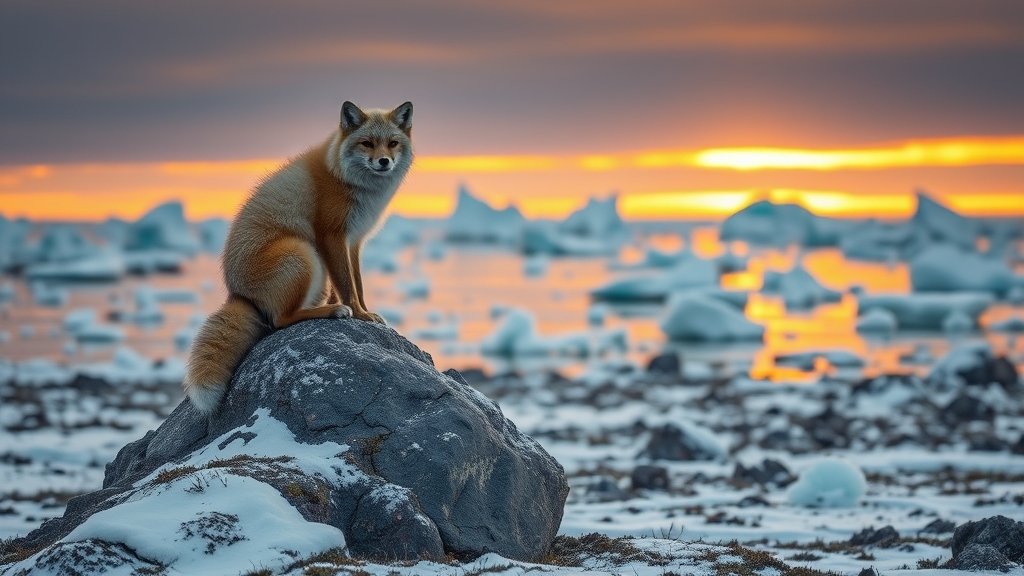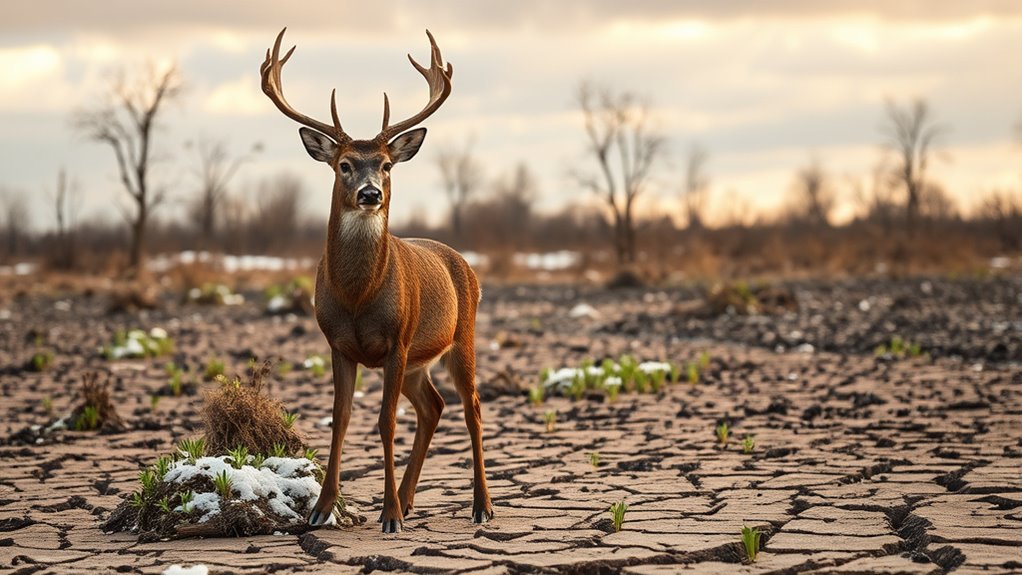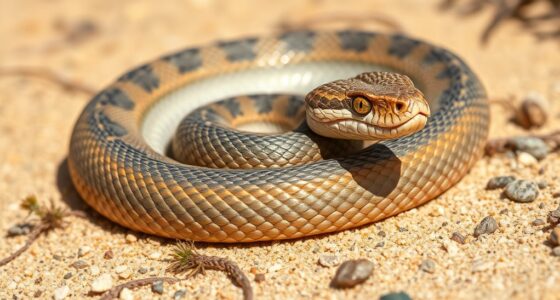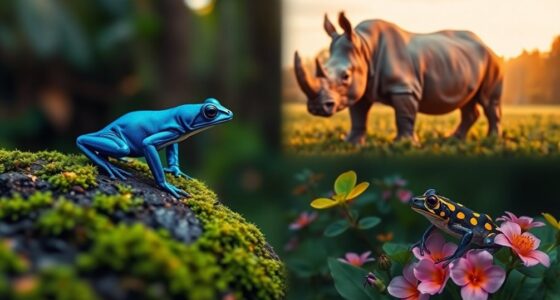As global temperatures rise, wildlife must adapt quickly to survive. You’ll see animals shifting habitats, moving to cooler areas, or altering behaviors. Some develop genetic changes for heat tolerance, but these adaptations can take time and may not keep pace with rapid climate change. Protecting migration routes and conserving genetic diversity are essential for resilience. To learn how these strategies work and what more can be done, keep exploring how ecosystems and species respond to this urgent challenge.
Key Takeaways
- Genetic diversity enables species to develop traits like heat tolerance, improving resilience to rising temperatures.
- Animals shift habitats to cooler areas, such as higher elevations or latitudes, to survive climate changes.
- Conservation efforts that protect migration corridors and restore habitats support natural adaptation processes.
- The pace of climate change may outstrip species’ ability to adapt genetically or through habitat shifts.
- Sustaining healthy populations and reducing global warming are vital for enhancing wildlife resilience in a warming world.

As global temperatures continue to rise, wildlife faces unprecedented challenges to survive and adapt. You might notice animals struggling to find suitable environments as their traditional habitats become inhospitable. In response, many species rely on genetic adaptation to keep pace with these rapid changes. Genetic adaptation involves changes in the DNA of populations over generations, equipping them with traits better suited to the new conditions. For example, some animals develop increased tolerance to higher temperatures or altered food sources. This process is often slow, but in some cases, it can be swift enough to help species survive in a warming world. You might observe that certain populations are evolving traits that enable them to withstand heat stress or scarce resources, which is vital for their continued existence. Genetic diversity plays a crucial role in providing the raw material for these adaptations to occur, increasing the likelihood of survival amid changing environments. Additionally, adaptive capacity is essential for species to respond effectively to environmental stressors, highlighting the importance of maintaining healthy, genetically diverse populations. Furthermore, species resilience can be strengthened through conservation actions that support genetic variation, helping animals better cope with environmental changes.
At the same time, habitat shifts are a primary way wildlife copes with climate change. As temperatures rise, animals are forced to move to cooler areas, often higher elevations or latitudes where conditions remain more stable. These shifts can be rapid, and they sometimes lead to new interactions among species or disruption of existing ecosystems. You may see animals migrating earlier in the year or extending their ranges into previously uninhabited regions. These movements are driven by the need to find suitable breeding grounds, food, and shelter, but they also pose challenges. Not all species can move quickly or find new habitats that support their survival, leading to potential declines or extinctions. Human-made barriers like urban development or deforestation can impede these natural migration processes, further complicating species’ ability to adapt.
The combination of genetic adaptation and habitat shifts demonstrates wildlife’s resilience, but it also highlights the limits of natural responses. Species that adapt through genetic changes might not do so fast enough to keep up with the pace of climate change. Similarly, habitat shifts can be hindered by human-made barriers like cities, farms, or infrastructure. As a result, some animals may become isolated in shrinking or declining habitats, making them more vulnerable to extinction. You should recognize that conservation efforts are essential to facilitate these natural adaptations. Protecting migration corridors, restoring degraded habitats, and supporting genetic diversity can help wildlife better navigate this changing world. Understanding the interplay between genetic adaptation and habitat shifts offers insights into how species might persist amid ongoing climate change, but it also underscores the urgency of reducing global warming to give wildlife a fighting chance to adapt and survive.
Frequently Asked Questions
How Do Individual Animals Adapt to Rapid Climate Changes?
You might wonder how individual animals adapt to rapid climate changes. They rely on behavioral plasticity, altering activities like feeding or migrating times to cope with new conditions. Physiological adaptation also plays a role, as some animals develop traits that help them withstand temperature shifts. These quick adjustments increase their chances of survival, allowing them to navigate the challenges posed by a rapidly changing environment effectively.
What Role Do Genetic Mutations Play in Resilience?
Like Darwin’s finches, you see that genetic mutations drive resilience by creating adaptive mutations. These changes increase genetic diversity, giving populations a better chance to survive climate shifts. When environments change rapidly, animals with beneficial mutations can better withstand new conditions. Your understanding of this process reveals how resilience hinges on the genetic variations within species, enabling some individuals to thrive despite the warming world.
Can Wildlife Corridors Effectively Support Species Migration?
Wildlife corridors can effectively support species migration by connecting fragmented habitats, like forest corridors, that habitat fragmentation has isolated. You can see these corridors as natural pathways allowing animals to move safely between habitats, which helps them access resources, breed, and adapt to changing conditions. By reducing barriers, you enable species to respond to environmental shifts, increasing their resilience and promoting healthier, more adaptable ecosystems.
How Do Invasive Species Impact Native Resilience?
Invasive species threaten native resilience by competing for resources, disrupting ecosystems, and sometimes introducing diseases. You might notice that native species struggle to survive or reproduce when invasive species dominate, weakening their ability to adapt to environmental changes. Their presence often diminishes biodiversity and ecosystem stability, making it harder for native populations to recover after disturbances. Managing invasive species is vital for maintaining the resilience of native wildlife and ecosystems.
What Are the Most Successful Conservation Strategies for Climate Adaptation?
Imagine you’re planting a resilient garden, shielding it from harsh storms. Successful conservation strategies for climate adaptation work similarly—by creating climate refugia, where species find safe haven, and focusing on habitat restoration to rebuild ecosystems. These efforts help wildlife adapt to changing conditions, ensuring their survival. You strengthen nature’s resilience, just like nurturing a garden to withstand future storms, fostering a sustainable balance for generations to come.
Conclusion
As the world’s climate shifts like a restless tide, your understanding becomes a lighthouse guiding wildlife through turbulent waters. Embrace the resilience woven into nature’s fabric, for it’s a affirmation to life’s stubborn hope. By acting now, you help plant seeds of change that can weather storms and bloom anew. Remember, you hold the power to nurture this fragile ecosystem—turning the tide from despair into a dawn of renewal and resilience.








